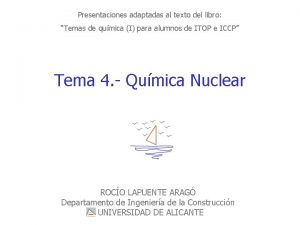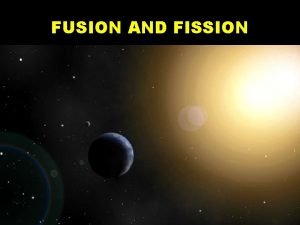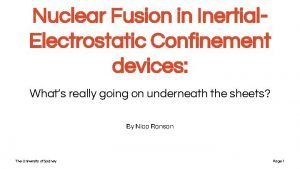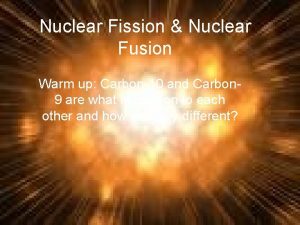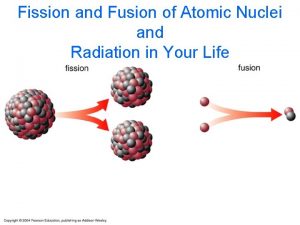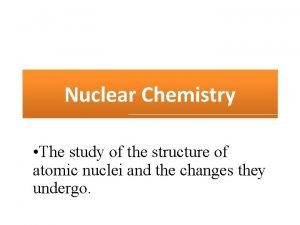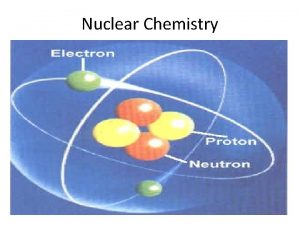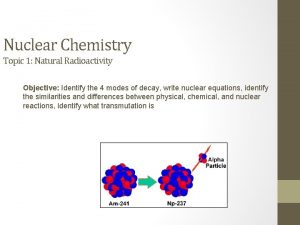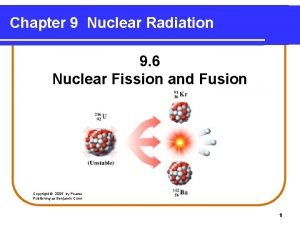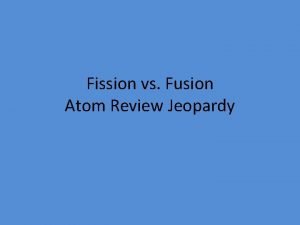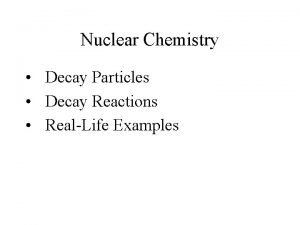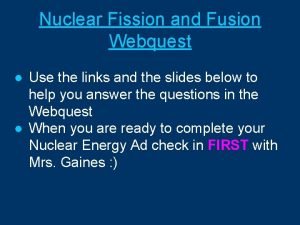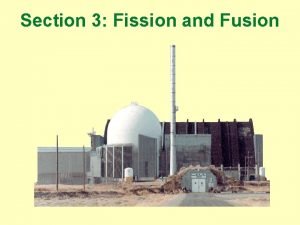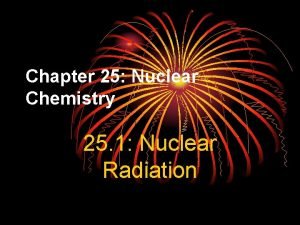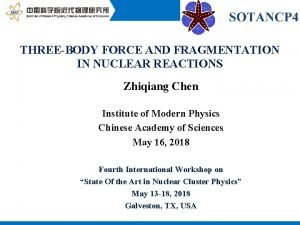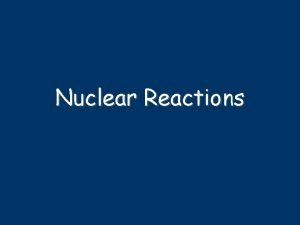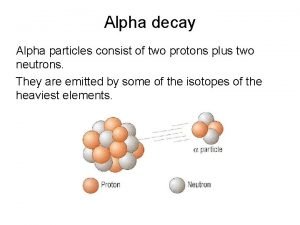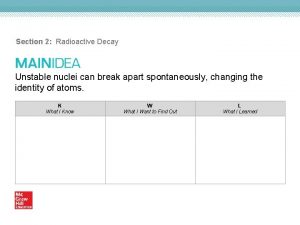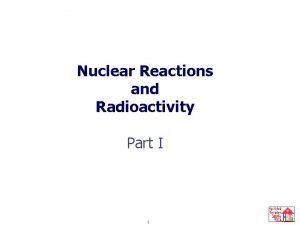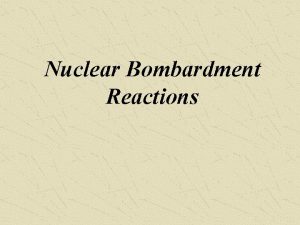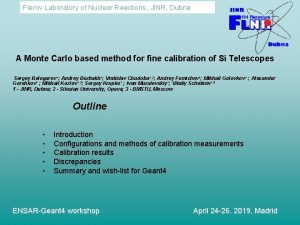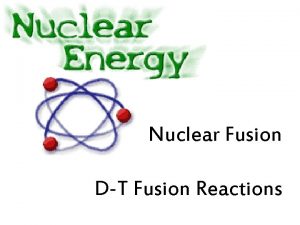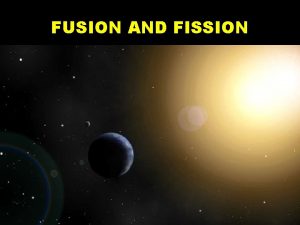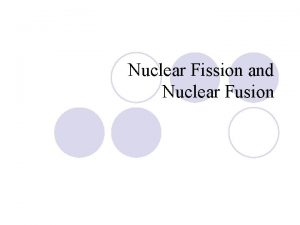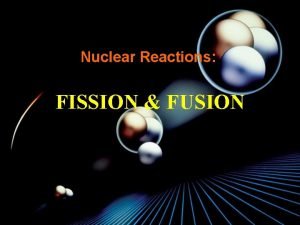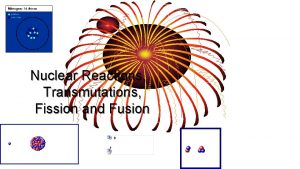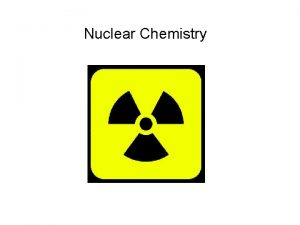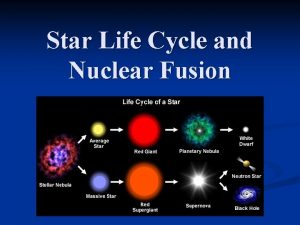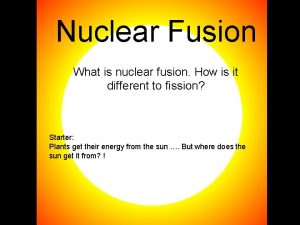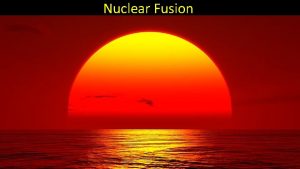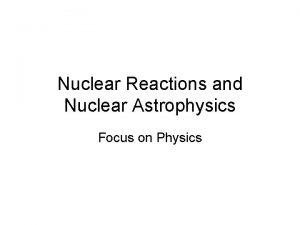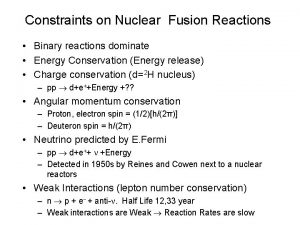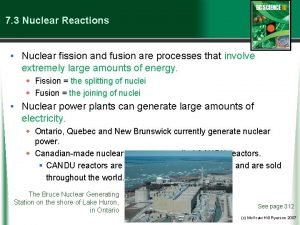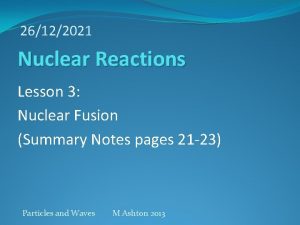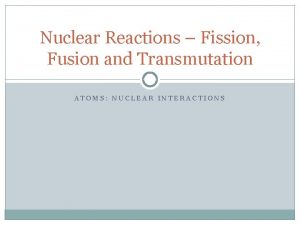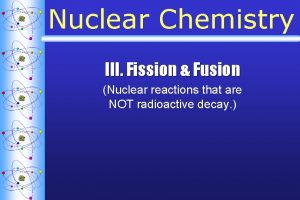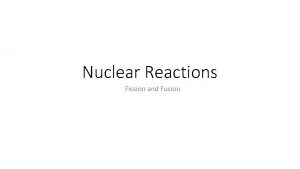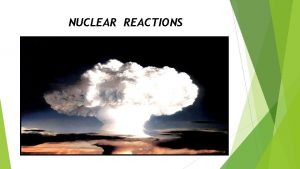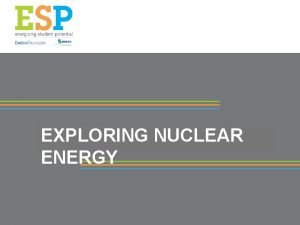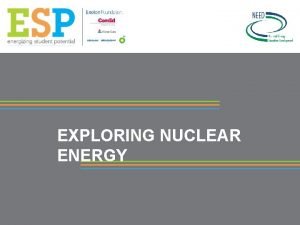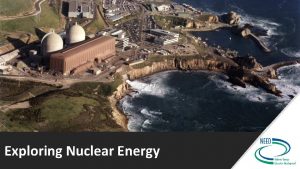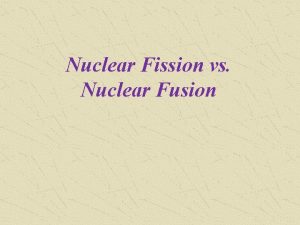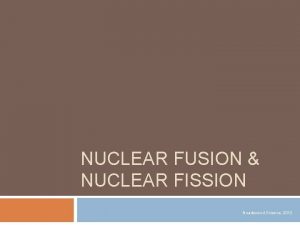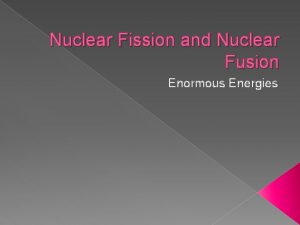Fusion reactions in nuclear astrophysics V V Sargsyan































- Slides: 31

Fusion reactions in nuclear astrophysics V. V. Sargsyan (BLTP, JINR) G. G. Adamian N. V. Antonenko H. Lenske (BLTP, JINR) (JLU, Giessen)

Key fusion reactions In a hydrogen-rich environment the light elements such as Li, Be, and B have all positive (p, α) Q values. These nuclei are easily destroyed, before fusion reactions start to play a role. The stable carbon isotopes 12, 13 C are the first nuclei with sufficiently negative (p, α) Q values. This makes 12 C + 12 C the first fusion reaction that needs to be considered in nuclear astrophysics. ü In non-explosive scenarios carbon fusion takes place in the center of massive stars toward the end of their lifetime during the carbonburning phase at temperatures of about 0. 6– 1 GK. ü In stellar explosions carbon fusion plays a role during the ignition phase of supernovae (1– 10 GK). Fusion reactions involving 16 O, plays a role only at higher temperatures. ü In explosive environments.

Key fusion reactions The study of fusion of light heavy nuclei (C, O, Si…) at extreme sub- barrier energies (e. g. Gamow energies for C+C reaction is 1 -3 Me. V) is a key to understand predict different scenarios of evolution of the stars. Main problem: Gamow energies are in a range where no reliable cross-section measurements can be made with present technologies. Possible solution: • Extrapolation of the existing experimental data to lower energies starting with data at higher energies. • Theoretical calculations.

S-factor More convenient representation of the fusion cross section at low energies Gamow factor --- Sommerfeld parameter --- beam velocity Some models predict, that the Gamow factor accounts for the main part of the strong energy dependence of the fusion cross section, such that the Sfactor exhibits only a weak energy dependence far below the Coulomb barrier. This feature is often used to extrapolate the cross section into the region of the Gamow window, in order to predict the astrophysical reaction rates.

S-factor for 16 O+16 O reaction • Existence of a maximum in S- factor ? • The maximum was observed in 64 Ni+64 Ni and 58 Ni+58 Ni reaction Jiang, PRC 93 2004 • The structure of S - factor is critical for the extrapolation of data!

S-factor for 12 C+12 C reaction • More dramatic situation in 12 C+12 C reaction ! • Resonant behavior at low energies does not allow to make a clear conclusion about the maximum.

The capture cross section For the light and medium-heavy nuclei the fusion is governed by the penetrability of the nuclei through the Coulomb and orbital angular momentum barriers (the so called capture). The capture cross-section is a sum of partial capture cross-sections Тhe partial capture probability at fixed energy and angular momentum Different approaches and models offer different methods of calculation of capture probability

The assumptions of the QD approach The quantum diffusion approach based on the following assumptions: 1. The capture (fusion) can be treated on the one collective variable: the relative distance between the colliding nuclei: R. 2. Collective coordinate is coupled to the internal excitations. 3. The internal excitations (for example, low-lying collective modes such as dynamical quadropole and octupole excitations of the target and projectile, single particle excitations etc. ) can be presented as an environment.

The formalism of QD approach The full Hamiltonian of the system: Ø The collective subsystem (inverted harmonic oscillator) Ø The internal subsystem Ø Coupling between the subsystems (linear coupling)

Approximation: realistic nucleus-nucleus potential inverted oscillator v The real interaction between nuclei can be approximated by the inverted oscillator. The frequency of oscillator is found from the condition of equality of classical action

The analytical expressions for the first and second moments Functions determine the dynamic of the first and second moments --- are the roots of the following equation

The capture probability in quantum diffusion approach Capture probability depends on the ratio of mean value and the variance of the collective coordinate: • The coupling to internal excitations leads to fluctuation of collective coordinate. • Equations for the mean value and variance contain friction and diffusion. • The friction and diffusion are obtained in a self-consistent way. Our approach takes into account the fluctuation and dissipation effects in the collisions of heavy ions which model the coupling with various channels.

The capture probability Constant friction coefficient was used. The frequency of the approximated oscillator. The internal excitation width --- �is responsible for non-Markovian effects. The QD approach was successfully applied to describe the heavy ion fusion reactions at near- and below the Coulomb barrier energies.

Nucleus-nucleus interaction potential: The calculated potentials respect to their barriers for the indicated reactions • The large Coulomb repulsion in case of the 16 O+208 Pb reaction leads to steep fall off of the potential, compared to those in case of 16 O+16 O reaction. • The same energy below the Coulomb barrier, two colliding nuclei approach to closer distance in case of the heavier system.

External turning point The dependence of the external turning point on energy is completely different for reactions with light and heavy nuclei! • The Rext indicates the extent of the overlap of nuclear density profiles, which responsible for the nuclear friction. • At the same energy below the barrier, the external turning point is located much closer to the position of the corresponding Coulomb barrier in case of heavy system. One need to include in model the dependence of friction on coordinate!

To consider reactions with light heavy nuclei one need to extend the model!! Ø Include the energy dependence of friction, (dependence of the friction on the external turning point). Ø At each energy, to find an effective “frequency”, which replace the real potential with an inverted oscillator in a proper way.

The friction is proportional to the square of the nuclear force: Gross, Phys. Rep. (1978) Weidenmuller, Prog. Part. Nucl. Phys. (1978) • This form of friction takes into account the comparatively larger overlap of the nuclear surfaces is case of two heavier nuclei. Determination of the “frequency” of the replaced oscillator: 1. The same height and the position of the barrier of the real potential with the height and the position of inverted oscillator. 2. The condition of equality of the energy under the barrier: Determination of the excitation width: Markovian limit

Probability at extreme sub-barrier energies At low energies (weak friction limit) one obtains simple expression for the capture probability ! --- Coulomb energy at R=Rb ü For very light nuclei the formulas are applicable already at energies 1 -2 Me. V below the barrier. ü The formulas could be used to obtain analytical expression for the S- factor position and reaction rates.

Results of calculations • The main trend of new experimental data is reproduced. • We clearly identify a maximum in S- factor.

Results of calculations • The calculation is in good agreement with the experimental data • The lowest data are very close to the position of the maximum of S factor

Results of calculations

Results of calculations

Comparison with the WKB model The fluctuation and dissipation effects taken into account in our model (solid line) increase fusion probability at sub-barrier energies and decrease at above barrier energies compared to WKB model (dashed line).

Reactions with heavier (medium mass) nuclei



Summary § In collisions of light nuclei at low sub-barrier energies, the external turning point is located far from the Coulomb barrier position. This means weak overlap of nuclear surfaces and, correspondingly, small friction. § We extended our QD approach and considered the friction depending on the bombarding energy. Using the extended approach, we compared the calculated capture cross-sections with the available experimental data. In all cases we obtained a good description of the experiments. § Comparing the fusion excitation functions calculated within the quantum diffusion and WKB approaches, we found that the fluctuation and dissipation increase fusion cross section at sub-barrier energies. § The maximum in S-factor is predicted. However, more experimental data at low energies is needed to confirm our predictions. § In the limit of weak friction, which corresponds to extreme sub-barrier energies, the analytic expression for the capture probability is obtained. This simple expression can be applied to the reactions of astrophysical interest. § The strong decline of fusion cross sections at sub-barrier energies considerably reduces the stellar burning rates and, moreover, leads to severe experimental problems, inhibiting the measurements in many cases.

Thank you!

Nucleus-nucleus interaction potential: Double-folding formalism used for nuclear part: Nucleus-nucleus potential: 1. density - dependent effective nucleon-nucleon interaction 2. Woods-Saxon parameterization for nucleus density Adamian et al. , Int. J. Mod. Phys E 5, 191 (1996).

Coordinate dependent friction The friction is proportional to the square of the nuclear force: Gross, Phys. Rep. (1978) Weidenmuller, Prog. Part. Nucl. Phys. (1978) the variation of � 0 2 times leads to the change of the results of the calculations less then 5% ! • This form of friction takes into account the comparatively larger overlap of the nuclear surfaces is case of two heavier nuclei. • The friction decreases more rapidly than the corresponding nuclear potential.

Propagator for the inverted oscillator Ø For the inverted oscillator the propagator has the form: --- the mean value of the collective coordinate and momentum --- the variances and Dadonov, Man’ko, Tr. Fiz. Inst. Akad. Nauk SSSR 167, 7 (1986). Ø The expression for the capture probability
 Lesson 15 nuclear quest nuclear reactions
Lesson 15 nuclear quest nuclear reactions Sona sargsyan
Sona sargsyan Diferencia entre fision y fusion nuclear
Diferencia entre fision y fusion nuclear Nuclear fission and fusion similarities
Nuclear fission and fusion similarities Nuclear fusion
Nuclear fusion Nuclear fusion
Nuclear fusion Who discovered uranium
Who discovered uranium Fusion fission
Fusion fission Fusion reaction example
Fusion reaction example Fusion nuclear
Fusion nuclear Nuclear fission and fusion similarities
Nuclear fission and fusion similarities Nuclear fusion radiation
Nuclear fusion radiation Nuclear fission and fusion similarities
Nuclear fission and fusion similarities Nuclear fission vs fusion venn diagram
Nuclear fission vs fusion venn diagram Radiant energy
Radiant energy Nuclear chemistry
Nuclear chemistry Nuclear fission and fusion webquest answer key
Nuclear fission and fusion webquest answer key What is fission and fusion
What is fission and fusion Chapter 25 nuclear chemistry
Chapter 25 nuclear chemistry Fisión nuclear vs fision nuclear
Fisión nuclear vs fision nuclear Nuclear reactions are at
Nuclear reactions are at Natural transmutation example
Natural transmutation example Carbon 14 decays by beta emission
Carbon 14 decays by beta emission Balancing nuclear reactions
Balancing nuclear reactions Two types of nuclear reactions
Two types of nuclear reactions Key terms radioactivity and nuclear reactions
Key terms radioactivity and nuclear reactions Nuclear decays and reactions section 2
Nuclear decays and reactions section 2 Gamma decay nuclear equation
Gamma decay nuclear equation Bombardment reactions
Bombardment reactions Two types of nuclear reactions
Two types of nuclear reactions Flerov laboratory of nuclear reactions
Flerov laboratory of nuclear reactions How to write a balanced redox reaction
How to write a balanced redox reaction


